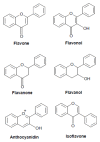Polyphenolic Flavonoid Compound Quercetin Effects in the Treatment of Acute Myeloid Leukemia and Myelodysplastic Syndromes
- PMID: 34641325
- PMCID: PMC8510366
- DOI: 10.3390/molecules26195781
Polyphenolic Flavonoid Compound Quercetin Effects in the Treatment of Acute Myeloid Leukemia and Myelodysplastic Syndromes
Abstract
Flavonoids are ubiquitous groups of polyphenolic compounds present in most natural products and plants. These substances have been shown to have promising chemopreventive and chemotherapeutic properties with multiple target interactions and multiple pathway regulations against various human cancers. Polyphenolic flavonoid compounds can block the initiation or reverse the promotion stage of multistep carcinogenesis. Quercetin is one of the most abundant flavonoids found in fruits and vegetables and has been shown to have multiple properties capable of reducing cell growth in cancer cells. Acute myeloid leukemia (AML) and myelodysplastic syndromes (MDS) therapy remains a challenge for hematologists worldwide, and the outcomes for patients with both disorders continue to be poor. This scenario indicates the increasing demand for innovative drugs and rational combinative therapies. Herein, we discuss the multitarget effects of the flavonoid quercetin, a naturally occurring flavonol, on AML and MDS.
Keywords: anti-proliferative effect; apoptosis; autophagy; epigenetic modifications; hematological disorders; polyphenolic compounds; quercetin.
Conflict of interest statement
The authors declare no conflict of interest. The funders had no role in the design of the study; in the collection, analyses, or interpretation of data; in the writing of the manuscript; or in the decision to publish the results.
Figures





Similar articles
-
Arsenic disulfide-triggered apoptosis and erythroid differentiation in myelodysplastic syndrome and acute myeloid leukemia cell lines.Hematology. 2014 Sep;19(6):352-60. doi: 10.1179/1607845413Y.0000000138. Epub 2013 Nov 25. Hematology. 2014. PMID: 24192507
-
Identification and validation of the dopamine agonist bromocriptine as a novel therapy for high-risk myelodysplastic syndromes and secondary acute myeloid leukemia.Oncotarget. 2016 Feb 9;7(6):6609-19. doi: 10.18632/oncotarget.6773. Oncotarget. 2016. PMID: 26735888 Free PMC article.
-
Focal Adhesion Kinase as a Potential Target in AML and MDS.Mol Cancer Ther. 2017 Jun;16(6):1133-1144. doi: 10.1158/1535-7163.MCT-16-0719. Epub 2017 Mar 7. Mol Cancer Ther. 2017. PMID: 28270436 Free PMC article.
-
Shutting Down Acute Myeloid Leukemia and Myelodysplastic Syndrome with BCL-2 Family Protein Inhibition.Curr Hematol Malig Rep. 2018 Aug;13(4):256-264. doi: 10.1007/s11899-018-0464-8. Curr Hematol Malig Rep. 2018. PMID: 29982865 Review.
-
Resveratrol, Piceatannol, Curcumin, and Quercetin as Therapeutic Targets in Gastric Cancer-Mechanisms and Clinical Implications for Natural Products.Molecules. 2024 Dec 24;30(1):3. doi: 10.3390/molecules30010003. Molecules. 2024. PMID: 39795061 Free PMC article. Review.
Cited by
-
The Overlooked Association Between Nutrition and the Development of Acute Myeloid Leukaemia: A Scoping Review.Curr Nutr Rep. 2024 Jun;13(2):113-125. doi: 10.1007/s13668-024-00522-2. Epub 2024 Mar 2. Curr Nutr Rep. 2024. PMID: 38430336 Free PMC article.
-
Curcumin in treatment of hematological cancers: Promises and challenges.J Tradit Complement Med. 2024 Jan 5;14(2):121-134. doi: 10.1016/j.jtcme.2023.10.004. eCollection 2024 Mar. J Tradit Complement Med. 2024. PMID: 38481552 Free PMC article. Review.
-
Sinensetin suppresses breast cancer cell progression via Wnt/β-catenin pathway inhibition.Transl Cancer Res. 2024 Jan 31;13(1):348-362. doi: 10.21037/tcr-23-1317. Epub 2024 Jan 12. Transl Cancer Res. 2024. PMID: 38410229 Free PMC article.
-
A Review of Classification, Biosynthesis, Biological Activities and Potential Applications of Flavonoids.Molecules. 2023 Jun 25;28(13):4982. doi: 10.3390/molecules28134982. Molecules. 2023. PMID: 37446644 Free PMC article. Review.
-
Oxidative Stress and Mitochondrial Dysfunction in Myelodysplastic Syndrome: Roles in Development, Diagnosis, Prognosis, and Treatment.Int J Mol Sci. 2025 Jul 3;26(13):6415. doi: 10.3390/ijms26136415. Int J Mol Sci. 2025. PMID: 40650192 Free PMC article. Review.
References
-
- Lakhanpal P., Rai D.K. Quercetin: A Versatile Flavonoid. Internet J. Med. Updat. 2007;2:20–35. doi: 10.4314/ijmu.v2i2.39851. - DOI
Publication types
MeSH terms
Substances
Grants and funding
LinkOut - more resources
Full Text Sources
Medical
Research Materials
Miscellaneous

